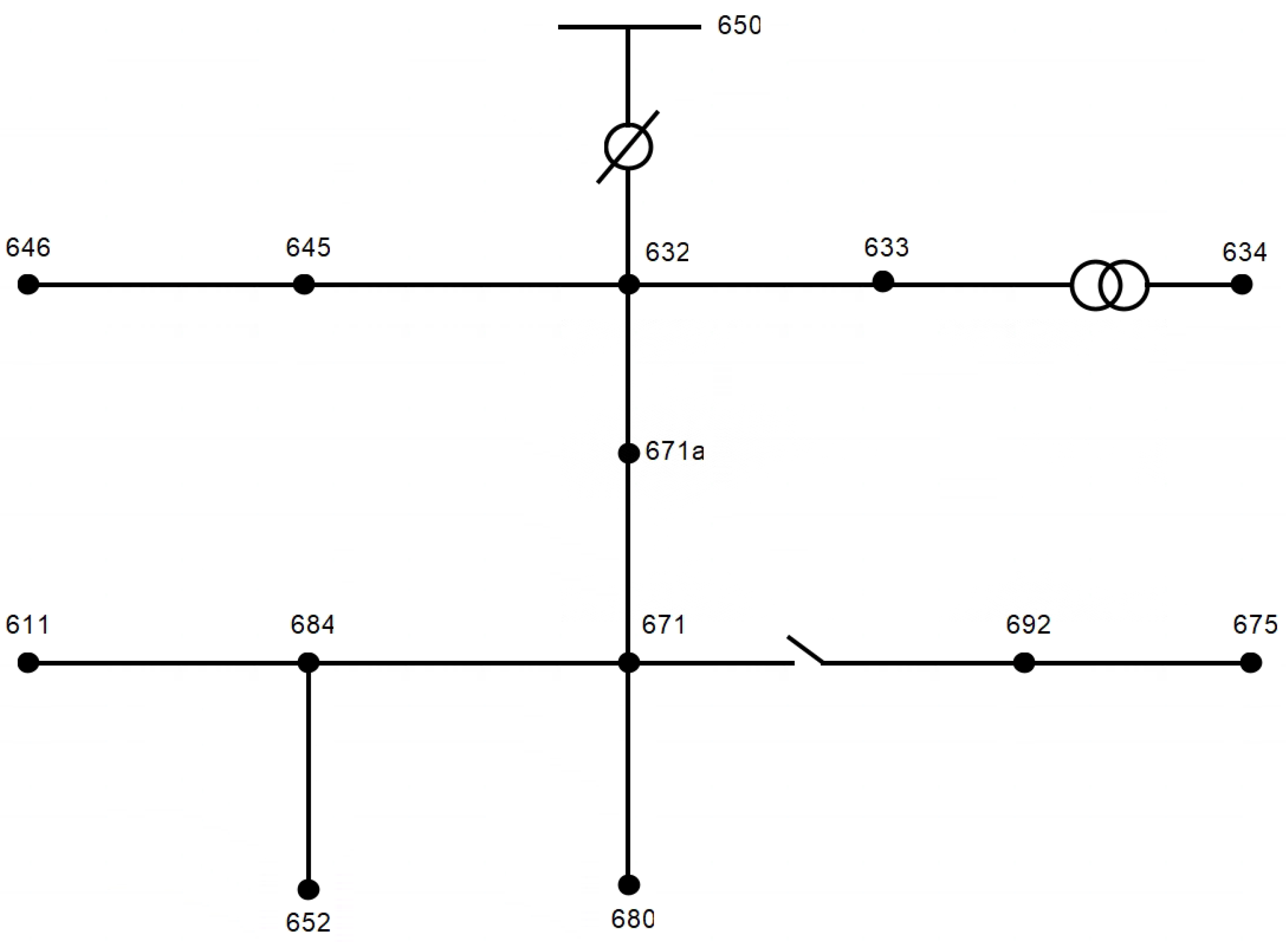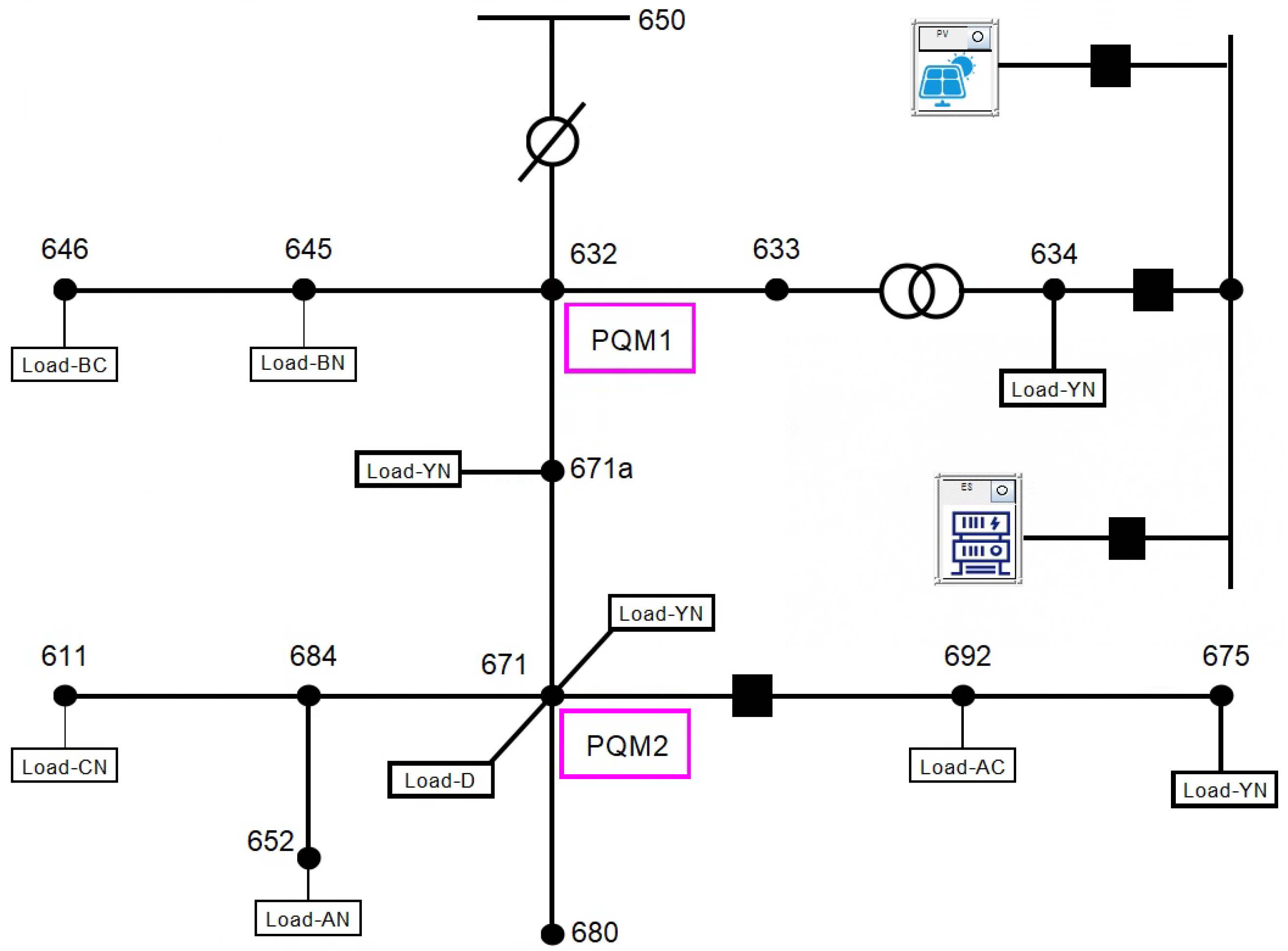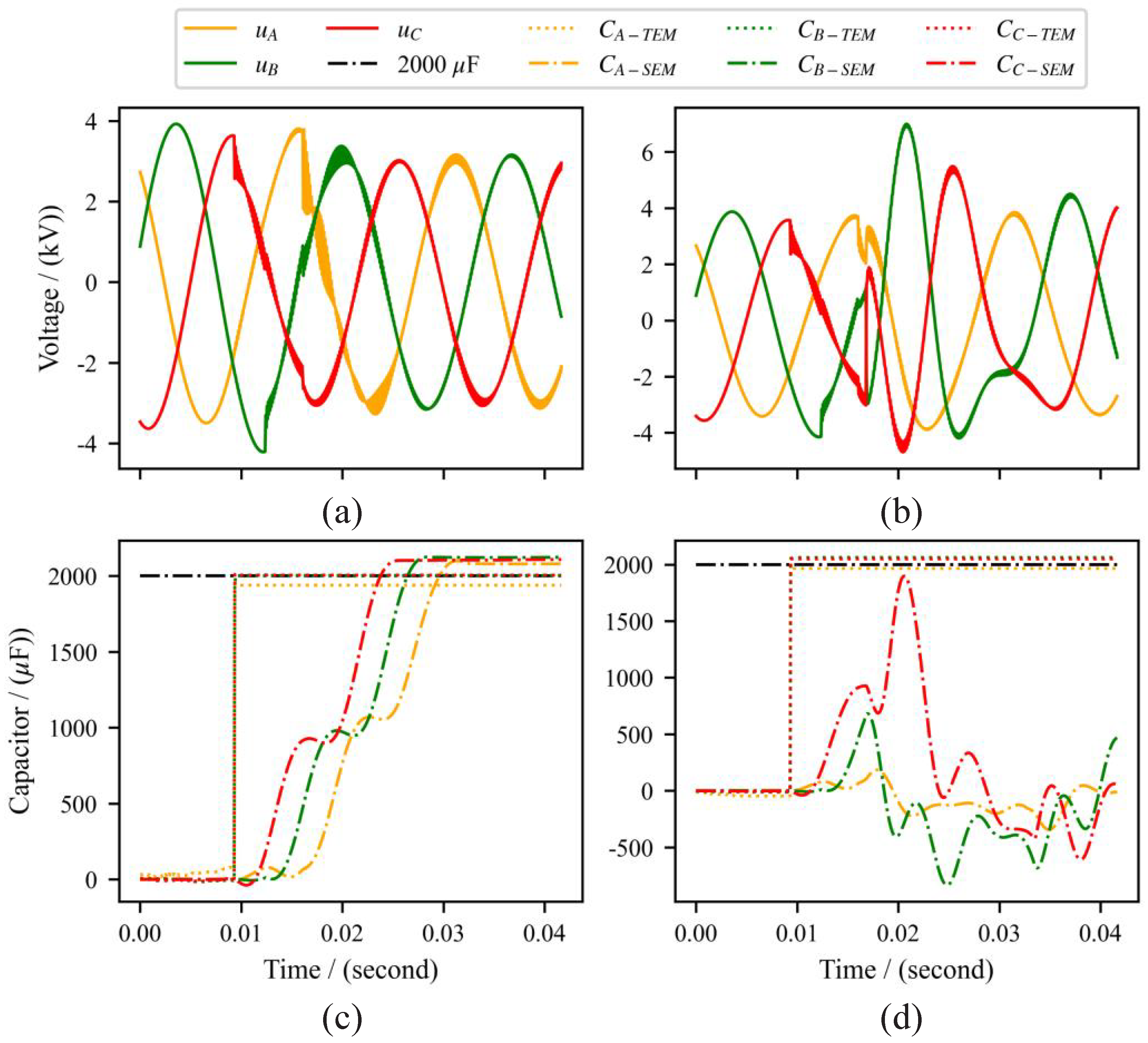Size Estimation of Bulk Capacitor Removal Using Limited Power Quality Monitors in the Distribution Network
Abstract
:1. Introduction
2. Methodology
2.1. Capacitor Removal Estimation
2.1.1. PQM Deployment Optimization
2.1.2. Disturbed Power Line Location
2.1.3. Capacitor Removal Calculation
- A.
- Steady-state estimation
- B.
- Transient Estimation
2.2. Method Application
2.2.1. Limited PQM Placement
2.2.2. Disturbance Localization
2.2.3. Capacitor Removal Amount
3. Result and Discussion
3.1. Worked Example
3.2. Impacts on Estimation Method
3.2.1. Disturbance Bus
3.2.2. Capacitor Size
3.2.3. Load Symmetry
3.2.4. Disturbance Duration
3.2.5. Distributed Generator
3.3. Discussion
4. Conclusions
Author Contributions
Funding
Institutional Review Board Statement
Informed Consent Statement
Data Availability Statement
Conflicts of Interest
Appendix A
References
- Rao, S.N.V.B.; Kumar, Y.V.P.; Pradeep, D.J.; Reddy, C.P.; Flah, A.; Kraiem, H.; Al-Asad, J.F. Power Quality Improvement in Renewable-Energy-Based Microgrid Clusters Using Fuzzy Space Vector PWM Controlled Inverter. Sustainability 2022, 14, 4663. [Google Scholar] [CrossRef]
- Fu, J.; Nunez, A.; De Schutter, B. A Short-Term Preventive Maintenance Scheduling Method for Distribution Networks With Distributed Generators and Batteries. IEEE Trans. Power Syst. 2021, 36, 2516–2531. [Google Scholar] [CrossRef]
- Naguib, M.; Omran, W.A.; Talaat, H.E.A. Performance Enhancement of Distribution Systems via Distribution Network Reconfiguration and Distributed Generator Allocation Considering Uncertain Environment. J. Mod. Power Syst. Clean Energy 2022, 10, 647–655. [Google Scholar] [CrossRef]
- Chen, S.; Li, Z.; Pan, G.; Xu, F. Power Quality Disturbance Recognition Using Empirical Wavelet Transform and Feature Selection. Electronics 2022, 11, 174. [Google Scholar] [CrossRef]
- Xiao, Y.; Ouyang, J.; Xiong, X.; Saha, A.K. A New Locating Method of Break Faults in an Active Distribution Network Based on Distributed Generator Monitoring. Int. Trans. Electr. Energy Syst. 2022, 2022, 4176869. [Google Scholar] [CrossRef]
- Shams, N.; Wall, P.; Terzija, V. Active Power Imbalance Detection, Size and Location Estimation Using Limited PMU Measurements. IEEE Trans. Power Syst. 2019, 34, 1362–1372. [Google Scholar] [CrossRef]
- Zu, X.; Wei, K. A simple gated recurrent network for detection of power quality disturbances. IET Gener. Transm. Distrib. 2021, 15, 751–761. [Google Scholar] [CrossRef]
- Su, D.; Li, K.; Shi, N. Power Quality Disturbances Recognition Using Modified S-Transform Based on Optimally Concentrated Window with Integration of Renewable Energy. Sustainability 2021, 13, 9868. [Google Scholar] [CrossRef]
- Liu, J.; Tang, Q.; Qiu, W.; Ma, J.; Qin, Y.; Sun, B. Automatic Power Quality Disturbance Diagnosis Based on Residual Denoising Convolutional Auto-Encoder. Appl. Sci. 2021, 11, 7637. [Google Scholar] [CrossRef]
- Kanagaraj, N.; Rezk, H. Dynamic Voltage Restorer Integrated with Photovoltaic-Thermoelectric Generator for Voltage Disturbances Compensation and Energy Saving in Three-Phase System. Sustainability 2021, 13, 3511. [Google Scholar] [CrossRef]
- Khan, U.A.; Yang, H.K.; Khan, A.A.; Park, J.W. Design and Implementation of Novel Noninverting Buck-Boost AC-AC Converter for DVR Applications. IEEE Trans. Ind. Electron. 2021, 68, 9346–9357. [Google Scholar] [CrossRef]
- Biricik, S.; Komurcugil, H.; Ahmed, H.; Babaei, E. Super Twisting Sliding-Mode Control of DVR With Frequency-Adaptive Brockett Oscillator. IEEE Trans. Ind. Electron. 2021, 68, 10730–10739. [Google Scholar] [CrossRef]
- Huang, S.; Dinavahi, V. GPU-based parallel real-time volt/var optimisation for distribution network considering distributed generators. IET Gener. Transm. Distrib. 2018, 12, 4472–4481. [Google Scholar] [CrossRef]
- Martinez, R.; Castro, P.; Arroyo, A.; Manana, M.; Galan, N.; Moreno, F.S.; Bustamante, S.; Laso, A. Techniques to Locate the Origin of Power Quality Disturbances in a Power System: A Review. Sustainability 2022, 14, 7428. [Google Scholar] [CrossRef]
- Serrano-Fontova, A.; Casals Torrens, P.; Bosch, R. Power Quality Disturbances Assessment during Unintentional Islanding Scenarios. A Contribution to Voltage Sag Studies. Energies 2019, 12, 3198. [Google Scholar] [CrossRef] [Green Version]
- Li, Z.; Liu, H.; Zhao, J.; Bi, T.; Yang, Q. A Power System Disturbance Classification Method Robust to PMU Data Quality Issues. IEEE Trans. Ind. Inform. 2022, 18, 130–142. [Google Scholar] [CrossRef]
- Azizi, S.; Jegarluei, M.R.; Dobakhshari, A.S.; Liu, G.; Terzija, V. Wide-Area Identification of the Size and Location of Loss of Generation Events by Sparse PMUs. IEEE Trans. Power Deliv. 2021, 36, 2397–2407. [Google Scholar] [CrossRef]
- Matsumori, H.; Urata, K.; Shimizu, T.; Takano, K.; Ishii, H. Capacitor loss analysis method for power electronics converters. Microelectron. Reliab. 2018, 88–90, 443–446. [Google Scholar] [CrossRef]
- Kingston, S.R.; Jayakumar, N.K.T.; Saleh, M.U.; Benoit, E.J.; Edun, A.S.; Sun, R.; Furse, C.M.; Scarpulla, M.A.; Harley, J.B. Measurement of Capacitance Using Spread Spectrum Time Domain Reflectometry (SSTDR) and Dictionary Matching. IEEE Sens. J. 2020, 20, 10102–10109. [Google Scholar] [CrossRef]
- Bastos, A.F.; Santoso, S. Universal Waveshape-Based Disturbance Detection in Power Quality Data Using Similarity Metrics. IEEE Trans. Power Deliv. 2020, 35, 1779–1787. [Google Scholar] [CrossRef]
- Cen, Z.; Stewart, P. Condition Parameter Estimation for Photovoltaic Buck Converters Based on Adaptive Model Observers. IEEE Trans. Reliab. 2017, 66, 148–160. [Google Scholar] [CrossRef]
- Khani, H.; Moallem, M.; Sadri, S.; Dolatshahi, M. A New Method for Online Determination of the Location of Switched Capacitor Banks in Distribution Systems. IEEE Trans. Power Deliv. 2011, 26, 341–351. [Google Scholar] [CrossRef]
- Elvira-Ortiz, D.A.; Saucedo-Dorantes, J.J.; Osornio-Rios, R.A.; Morinigo-Sotelo, D.; Antonino-Daviu, J.A. Power Quality Monitoring Strategy Based on an Optimized Multi-Domain Feature Selection for the Detection and Classification of Disturbances in Wind Generators. Electronics 2022, 11, 287. [Google Scholar] [CrossRef]
- Ibrahim, A.A.; Khalid, K.; Shareef, H.; Kamari, N.A.M. A Bounded Exhaustive Search Technique for Optimal Phasor Measurement Unit Placement in Power Grids. Symmetry 2020, 12, 2021. [Google Scholar] [CrossRef]
- Zhao, L.; Long, Y. An Improved PSO Algorithm for the Classification of Multiple Power Quality Disturbances. J. Inf. Process. Syst. 2019, 15, 116–126. [Google Scholar] [CrossRef]
- Ibrahim, A.A.; Mohamed, A.; Shareef, H. Optimal power quality monitor placement in power systems using an adaptive quantum-inspired binary gravitational search algorithm. Int. J. Electr. Power Energy Syst. 2014, 57, 404–413. [Google Scholar] [CrossRef]
- Branco, H.M.G.C.; Oleskovicz, M.; Coury, D.V.; Delbem, A.C.B. Multiobjective optimization for power quality monitoring allocation considering voltage sags in distribution systems. Int. J. Electr. Power Energy Syst. 2018, 97, 1–10. [Google Scholar] [CrossRef]
- Kempner, T.R.; Oleskovicz, M.; Gomes, D.P.S. Optimal monitoring of voltage sags through simultaneous analysis of short-circuits in distribution systems. IET Gener. Transm. Distrib. 2017, 11, 1801–1808. [Google Scholar] [CrossRef]
- Eldery, M.; El-Saadany, E.; Salama, M.; Vannelli, A. A novel power quality monitoring allocation algorithm. IEEE Trans. Power Deliv. 2006, 21, 768–777. [Google Scholar] [CrossRef]
- Branco, H.M.G.C.; Oleskovicz, M.; Delbem, A.C.B.; Coury, D.V.; Silva, R.P.M. Optimized allocation of power quality monitors in transmission systems: A multiobjective approach. Int. J. Electr. Power Energy Syst. 2015, 64, 156–166. [Google Scholar] [CrossRef]








| Power Line | Voltage | Current | Phase Difference |
|---|---|---|---|
| 1 | |||
| 2 | |||
| 3 | |||
| 4 | |||
| ⋮ | ⋮ | ⋮ | ⋮ |
| Bus | 650 | 632 | 633 | 645 | 671a | 646 | 671 | 684 | 680 | 692 | 611 | 652 | 675 | 634 |
|---|---|---|---|---|---|---|---|---|---|---|---|---|---|---|
| X | 0 | 1 | 0 | 0 | 0 | 0 | 1 | 0 | 0 | 0 | 0 | 0 | 0 | 0 |
| DX | 1 | 2 | 1 | 1 | 2 | 1 | 2 | 1 | 1 | 1 | 1 | 1 | 1 | 1 |
| Parameter | Value | Parameter | Value | Parameter | Value |
|---|---|---|---|---|---|
| rated voltage (L-L) | 4.16 kV | system frequency | 60 Hz | duration | 2 |
| capacitor removal | 3000 F | sampling frequency | 16,667 Hz | * start phase | 0 |
| Power Line | Power/kVar | Power Line | Power/kVar | Power Line | Power/kVar |
|---|---|---|---|---|---|
| 632to633A | 0.003 | 632to633B | 0.002 | 632to633C | 0.003 |
| 632to671aA | 10.125 | 632to671aB | 14.91 | 632to671aC | 16.893 |
| 632to650A | −10.128 | 632to650B | −14.908 | 632to650C | −16.752 |
| ∖ | ∖ | 632to645B | −0.05 | 632to645C | −0.144 |
| 671to692A | 12.489 | 671to692B | 19.891 | 671to692C | 23.531 |
| 671toLdA | 0.016 | 671toLdB | 0.007 | 671toLdC | −0.023 |
| 671toLyA | 0.0 | 671toLyB | 0.0 | 671toLyC | −0.001 |
| 671to671aA | −12.401 | 671to671aB | −19.908 | 671to671aC | −23.432 |
| 671to680A | 0.0 | 671to680B | 0.0 | 671to680C | 0.0 |
| 671to684A | −0.108 | ∖ | ∖ | 671to684C | −0.092 |
| Estimated Method | 671to692A | 671to692B | 671to692C |
|---|---|---|---|
| SEM | 3002.062 + 47.488 j | 2997.811 + 66.432 j | 3012.031 + 42.31 j |
| TEM | 2915.89 | 2990.901 | 2964.647 |
Publisher’s Note: MDPI stays neutral with regard to jurisdictional claims in published maps and institutional affiliations. |
© 2022 by the authors. Licensee MDPI, Basel, Switzerland. This article is an open access article distributed under the terms and conditions of the Creative Commons Attribution (CC BY) license (https://creativecommons.org/licenses/by/4.0/).
Share and Cite
Tan, M.; Zhang, C.; Chen, B. Size Estimation of Bulk Capacitor Removal Using Limited Power Quality Monitors in the Distribution Network. Sustainability 2022, 14, 15153. https://doi.org/10.3390/su142215153
Tan M, Zhang C, Chen B. Size Estimation of Bulk Capacitor Removal Using Limited Power Quality Monitors in the Distribution Network. Sustainability. 2022; 14(22):15153. https://doi.org/10.3390/su142215153
Chicago/Turabian StyleTan, Mingang, Chaohai Zhang, and Bin Chen. 2022. "Size Estimation of Bulk Capacitor Removal Using Limited Power Quality Monitors in the Distribution Network" Sustainability 14, no. 22: 15153. https://doi.org/10.3390/su142215153







